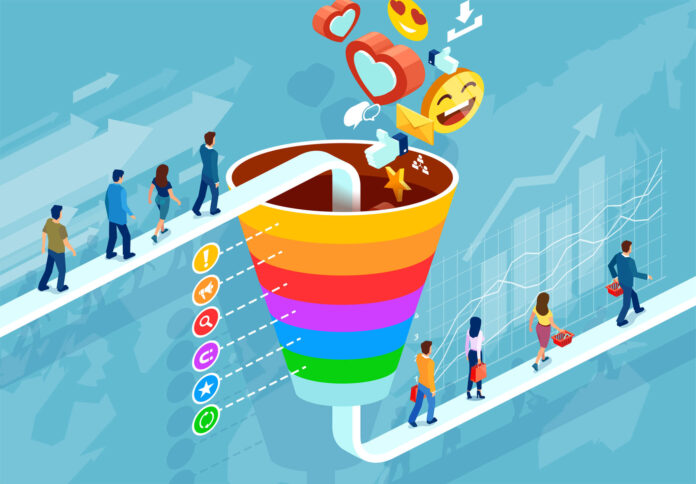A visual depiction of the customer journey that shows prospective customers’ various stages before making a purchase is referred to as a “funnel” in the context of marketing and sales. The comparison to a funnel is made because, like a funnel, potential clients or leads are typically more numerous at the top and gradually decrease as they move through the stages.
When analyzing the upper funnel vs. lower funnel, it’s essential first to define the two main stages of the funnel.
Top of the funnel (TOFU) stands for the first stage of a company’s customer journey or sales process. The bottom of the funnel (BOFU) is the final stage in the marketing and sales funnel.
Effective Funnel Engagement
The interaction and involvement that people have with a brand, its content, products, or services is referred to as engagement in marketing. It is a gauge of how successfully a brand or marketer can pique their intended market’s curiosity, interest, and behavior.
Meetings can take place through many different channels and touchpoints, both online and offline, and it is essential for establishing connections, increasing brand recognition, and ultimately boosting sales and patronage.
Here are some critical aspects of engagement in marketing:
- Interaction with the audience: Engagement frequently entails actions on the part of the audience, such as liking, sharing, commenting on, or responding to content.
- Engagement with content: Excellent and pertinent content is a crucial engagement factor.
- Engagement on social media platforms: These platforms are essential sources of interaction.
- Email engagement: The success of email marketing depends on the recipients’ ability to open emails, click on links, and perform other desired actions.
- Engagement with current customers is essential in addition to bringing in new ones.
- Engagement measurement: Engagement is quantified using metrics and analytics tools.
- Engagement strategies: Marketers employ various strategies to boost engagement.
- Brand loyalty: High levels of engagement can lead to increased brand loyalty.
- Customer feedback: Engagement can also involve gathering feedback and insights from customers.
In marketing, engagement is a complex idea beyond straightforward metrics and figures. A brand needs to be able to connect emotionally and interactively with its audience to build relationships, trust, and long-lasting customer loyalty. An effective marketing strategy must include engagement strategies because they are specialized to the unique needs and preferences of the target audience.
Top of the Funnel (TOFU) Engagement
- Content marketing: Produce educational and informative content that speaks to the concerns and passions of your target audience. Infographics, videos, blog posts, and eBooks can all be used to draw in and inform potential customers.
- Sharing your content on social media sites will help you reach a larger audience. Use targeted advertising to raise brand awareness while interacting with users by responding to comments and messages.
- Search engine optimization (SEO): To increase your website’s visibility in search results and draw organic traffic, optimize it for search engines.
- Public relations: Create press releases and media coverage to broaden brand awareness and credibility.
- Webinars and Events: Organize webinars, workshops, or other gatherings highlighting your knowledge and benefit your target market.
Middle of the Funnel (MOFU) Engagement
- Create and distribute targeted email campaigns to nurture leads using email marketing. To aid tips in making wise decisions, offer more in-depth content, case studies, and product details.
- Offer helpful resources, such as ebooks, whitepapers, or templates, in exchange for contact information using lead magnets and opt-in forms. Use opt-in forms strategically throughout your website.
- Retargeting ads: Display ads to website visitors who have visited your site before but have not bought anything. Remind them of your products or services and highlight their benefits.
- Showcase customer endorsements, reviews, and case studies to establish credibility and trust.
- Drip Campaigns: To keep leads interested and informed, set up automated email sequences that disperse pertinent content over time.
Bottom of the Funnel (BOFU) Engagement
- Personalization: Tailor your messaging to each lead’s unique requirements and taste. To send individualized offers and suggestions, use data and segmentation.
- Make it simple for leads to take the desired action, such as buying something, signing up for something, or requesting a quote with a clear call-to-action (CTA). Use compelling CTAs that highlight the benefits.
- Limited-time offers: To motivate quick action, create a sense of urgency with limited-time promotions and discounts.
- Live chat and customer support: Provide prompt assistance for any last-minute queries or issues via live chat or customer support.
- Send automated emails to users to remind them of the items they have forgotten to add to their shopping carts and to entice them to finish the transaction.
- Remember that these tactics’ success depends on your target market, sector, and type of goods or services. You must conduct ongoing analysis, testing, and optimization to optimize your engagement strategies and raise conversion rates at every funnel stage.



